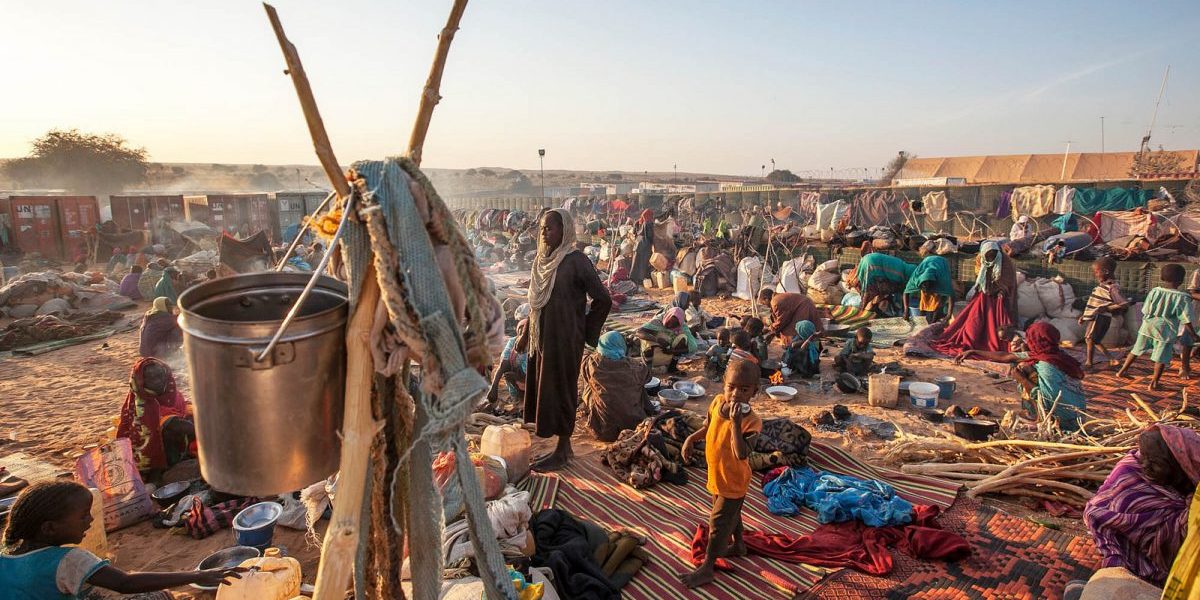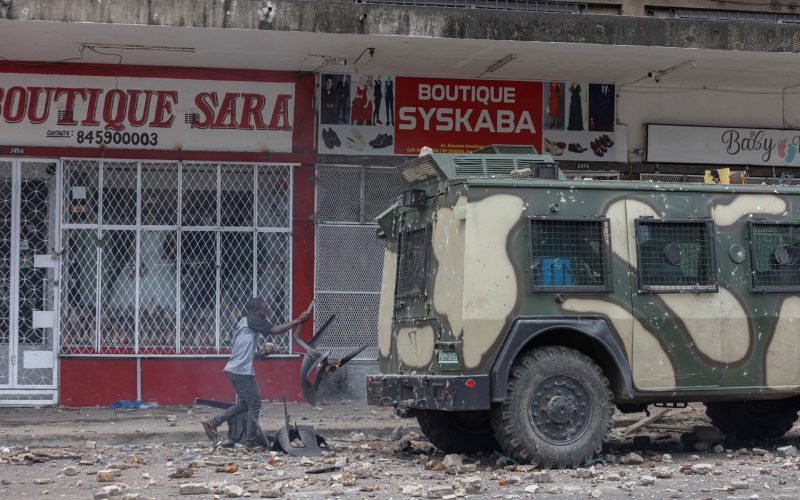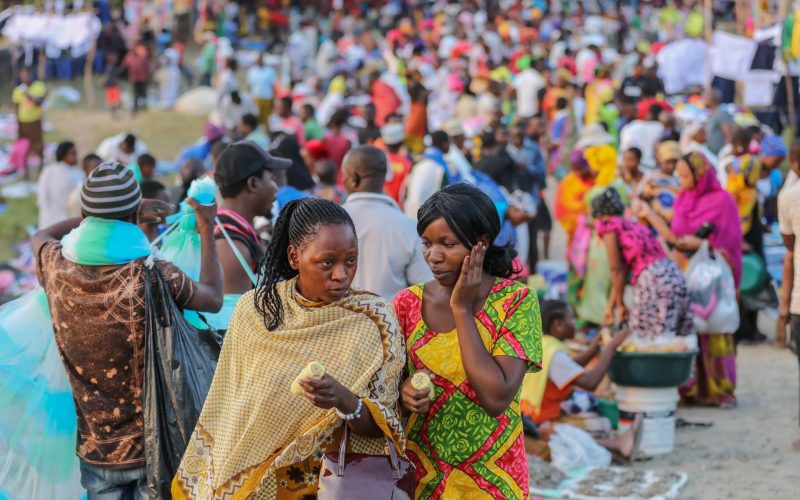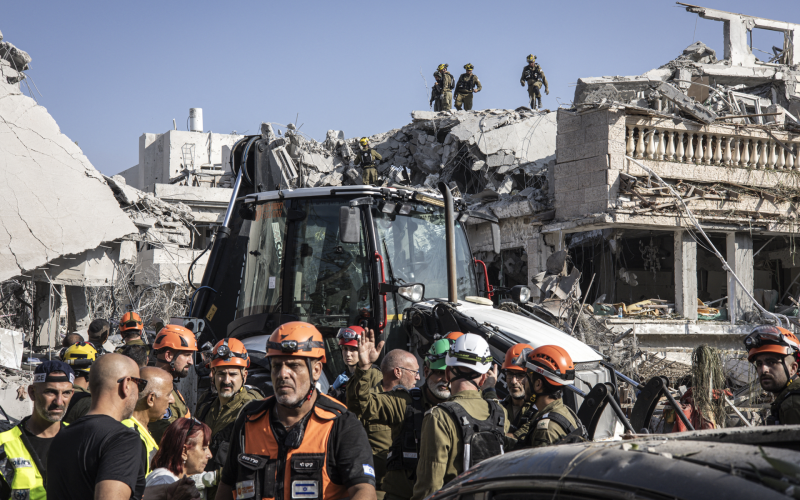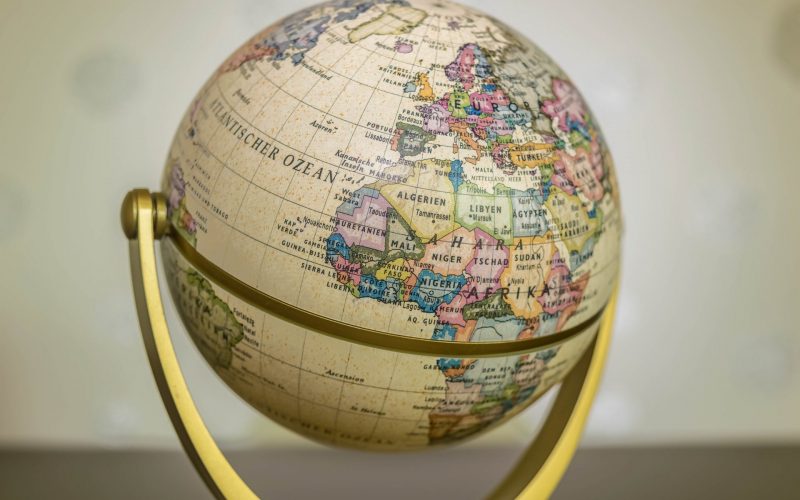In the Abu Shouk camp for internally displaced people in northern Darfur, Sheikh Adam invited guests to join him on an old woven mat in the shade of a towering water tank. Jumbled rows of fragile shelters stretched out behind him. As he removed his leather slippers, he calmly recounted the story of the time when Sudanese soldiers attacked Abu Delieg, the village where he was an elder.
‘The first time they came, it was for revenge because they think we support the rebels. The army knows we are ordinary people. But they think the families are families of the Tora Bora,’ Sheikh Adam said, referring to the government’s epithet for Sudanese Liberation Movement/Army (SLA) rebels. The nickname refers to the Al Qaeda and Taliban resistance fighters who holed up in the caves of Afghanistan’s Tora Bora region to hide from the US military.
In the weeks preceding the attack, the SLA had moved into the area surrounding the village, taken over the local police station and established a camp about seven kilometres from Abu Delieg. Sheikh Adam said the rebels declared his village a ‘liberated area’ and did not harm his people. Many of the SLA soldiers are from the Zaghawa tribe, as are some Abu Delieg villagers.
‘The military call our women Tora Bora women, children are Tora Bora children. Everything is Tora Bora. Those words we’d heard since long ago, but that day when they attacked, they didn’t say anything,’ he said.
The Sudanese army trucks arrived on market day while the SLA rebels were away. Abu Delieg was crowded with herders from nearby villages, their livestock in tow. The Sheikh estimates there were some 150 government soldiers toting Kala-shnikovs and G3 rifles. There were three armoured personnel carriers. Camouflaged men poured out of eight Landcruisers with machine guns trained at the crowd and surrounded the market. Sheikh Adam said there were military men with three, four and five stars on their arms. They shot everything that moved, including children and animals.
A bout a month later, the soldiers returned to Abu Delieg, but this time they were joined by two military helicopter gunships and a group of government-supported Arab nomadic militias known as Janjaweed. They struck the centre of town and sent all of the villagers fleeing for their lives. Several hundred made the journey 70 kilometres north to seek shelter near North Darfur’s capital, El Fasher. The remaining inhabitants are living in the surrounding bush tending the remnants of their livestock. The village is empty.
The attacks on Abu Delieg in August and September of this year were flagrant violations of a cease-fire signed by the Khartoum govern-ment and the two rebel movements, the SLA and the more nebulous Justice and Equality Movement (JEM), in May. These were not isolated events. On the contrary, violence and fighting are increasing again. Nearly 2 million people have been forced to flee their homes by Janjaweed and military attacks and ongoing fighting with the SLA since early 2003. Countless are dead.
Several rounds of Nigerian-sponsored peace talks aimed at resolving the 20-month-old conflict that has ravaged the expansive desert region of Darfur in western Sudan have thus far proven unsuccessful. Talks are once again underway in Abuja after being abandoned a month ago by the SLA rebels, who refuse to disarm before the government-backed Janjaweed militias give up their own weapons.
While the talks remain locked in stalemate, systematic and spontaneous attacks have intensified since late August, driving tens of thousands more civilians like Sheikh Adam from their homes into hundreds of burgeoning camps punctuating the Darfuri landscape and spilling across into neighbouring Chad. Poorly funded aid agencies, who are finally gaining free access throughout Darfur after a bitter struggle with the government, grapple to keep pace with the growth of the crisis.
Many of the routes delivering food, medicine and other necessary relief to hundreds of thousands of homeless in Darfur are increasingly labeled ‘no-go’ areas because of stepped up fighting from all sides, though many foreign non-governmental organisations have defied UN warnings in attempts to provide assistance. In early November the UN said some 160,000 people were inaccessible due to growing insecurity. The World Health Organisation (WHO) announced that at least 70,000 people had died in the camps from disease and malnutrition since March 2004.
No going home
The internally displaced are too traumatised and frightened to leave the camps for fear of being raped, injured or killed by the Janjaweed and other men in uniform. Many women who have taken the risk to collect firewood or tend their fields have paid dearly for doing so. And for the large majority of the displaced, there is no going home. After the villages are emptied, they are often destroyed. Homes are reduced to ash, and neglected crops wither in the unforgiving Sudanese sun.
The Darfuri displaced ‘are living in prisons without walls,’ said Louise Arbour, UN High Commissioner for Human Rights, after touring the region in late September. ‘Displaced people cannot return home because they do not trust the government of Sudan to protect them. At best they feel the authorities respond inadequately to their concerns, and at worst that they are in collusion with their abusers – including armed groups and militias generally described as Janjaweed.’
The roots of the Darfur crisis are grounded in decades of history. Divided into three states – North, South and West – the region was annexed by the British colonial government in 1916. Many parallels can be drawn between the emergence of the Darfur insurgency in February 2003 and the civil war with the south, where rebels rose up in arms 21 years ago as a result of marginalisation. Since Sudanese independence in 1956, Darfur – which means ‘land of the Fur’, one of the region’s main African tribes – has also been denied upliftment by the Arab-led regimes in Khartoum. The region has few schools or clinics, and electricity and running water are rare.
The Janjaweed – loosely translated, it means ‘Devils on Horseback’ – have become synonymous with the nomadic Arab herders who have followed seasonal migratory patterns in Darfur for centuries. Traditionally, they travel to southern Darfur in the dry season in search of grazing land for their livestock. When the rains return to Darfur from August through to October, swelling seasonal rivers, or wadis, that slice through the region’s harsh terrain, the nomadic tribes retreat to the fringes of the Sahel desert in the north.
Both the nomadic Arabs and the farming African tribes adhere to Islam and long-ago forged a symbiotic – if not entirely warm – relationship. In his July article Counter-Insurgency on the Cheap, Sudan expert Alex De Waal explains that, traditionally, when the nomads appeared, the host community would present them with a slaughtered animal before they unleashed their camels to graze in harvested pastures. In return, the livestock would fertilise the fields ahead of the planting season. When it came time for them to leave again, the nomads would give their African hosts a camel or two – the most valuable of currencies – in gratitude.
Over the centuries, blood lines have intermingled, laying waste to the polarised definitions of ‘African’ and ‘Arab.’ Individuals classify themselves as one or the other, but in reality the distinctions are less clear. (See opinion, page 10). Vanishing resources caused by gradual desertification and a drought that burned through Darfur in 1984-1985 fanned tensions between pastoralist nomad and farmer. Small scale clashes began to erupt and individuals armed themselves to protect their resources.
Complicating matters, as De Waal points out, Col. Muammar Gaddafi in neighbouring Libya hatched a grand plan in the late 1980s to create an ‘Arab Belt’ across the Sahel. He armed disillusioned Arabs across the Sudanese border in Chad to form an Islamic Legion. They used Darfur as a rear base, pillaging crops and cattle from the local population. Among the legionnaires were Arabs from western Sudan. Although Gaddafi’s dreams were short-lived, the residual effects of his efforts endure in Darfur. Many of today’s Janjaweed are thought to have been trained in Libya.
In 1989, Omar al-Bashir’s National Islamic Front (NIF) toppled Sadiq al-Mahdi’s government in Khartoum. Bashir preserved the Arab ruling elite in Khartoum and re-instituted the colonial-era ‘native administration’ system of provincial government, which was given very little resources for services and consolidated local powers, particularly over land distribution, in the hands of a few loyalists.
In the meantime, the NIF’s powerful chief cleric, Hassan al-Turabi, set off on a course of his own to spread political Islam across the region among the African Muslim tribes in Darfur. As Turabi gained in popular strength beyond Khartoum, a split widened between the president and the cleric, and Bashir sacked Turabi as Speaker of the National Assembly and subsequently arrested him. Since then, Turabi has been in and out of state custody and was, until recently, under house arrest.
Seeds of discontent
But by the turn of the century, momentum had started gathering toward rebellion in the west. After Turabi was dismissed, his supporters, primarily students and regional Islamists, formed the Popular Congress Party. With their ally imprisoned, a Darfuri Islamic group that would become the JEM, produced a ‘black book’ detailing a history of marginalisation and their under-representation in national government since independence. At the same time, a secular group largely comprised of the African Zaghawa tribe, emerged, calling itself the Darfur Liberation Front.
Emboldened by the gains made at the US-backed peace talks in Kenya by the southern Sudanese People’s Liberation Movement/Army (SPLM/A), against whom Khartoum has waged a 21-year war, the liberation front changed its name to the Sudanese Liberation Army, or SLA, in February 2003. In April of that same year, the SLA launched its first full-scale attack against a Sudanese military installation at El Fasher airport in North Darfur. The war had begun. Nobody anticipated the scale of human suffering that was to follow.
In a move to quash the rebellion in the months that followed, Bashir’s government followed a strategy that had worked well in the south, enlisting the help of local paramilitaries. Enter the Janjaweed. Empowered with weapons, these and other militias turned on the unarmed civilian population of Darfur.
Scorching the earth
In village after village, the militias butchered men and boys and stuffed their bodies down the common wells. Homes were burned to the ground and belongings were looted. Women and girls were systematically raped. Hundreds of thousands of civilians have fled, some escaping to distant cities or larger villages beyond the line of fire, others to the cave-pocked mountain regions controlled by the SLA, and others still into dozens of camps inside and across the border with Chad.
Back in Khartoum, in a grand act of Sudanese theatre, the streets of the capital were choked with military checkpoints on 24 September as security forces searched cars and homes for weapons and ‘coup plotters.’ The government subsequently announced it had averted a major act of sabotage, asserting that Turabi’s Darfuri supporters had conspired to assassinate top leaders and blow up key installations in Khartoum. Turabi has since been moved to the capital’s Kobar prison.
From a bird’s eye view, Darfur’s human topography has been drastically altered. Desolate stretches of fallow fields are the only evidence left of the nearly 2 million people who have been ‘cleansed’ from rural Darfur. The clusters of congested camps, their inhabitants threatened by disease and malnutrition, testify both to the scale of the crisis and the failure to prevent it.
Khartoum desperately tried to keep the atrocities hidden from foreign eyes. For a long time, it succeeded. As the violence has unfolded, the Sudanese government has erected bureaucratic roadblocks to the international community, refusing to grant aid agencies or journalists entry to the region. It virtually sealed off Darfur’s borders, perhaps hoping to put an end to the rebellion before outsiders could see it. At a delicate moment in the north-south peace process in Naivasha, Kenya, to which large amounts of foreign aid were tied, Khartoum could ill-afford to let another humanitarian crisis complicate matters.
But by March 2004, on the eve of the 10th anniversary of the start of the 1994 Rwandan genocide, during which the militant Hutu government incited its supporters to kill about 800,000 Tutsis and moderate Hutus, Khartoum could no longer avert an international outcry over Darfur. Outgoing UN Humanitarian Coordinator for Sudan Mukesh Kapila implored the world to stop the silent crisis. He decried Darfur as ‘the world’s greatest humanitarian and human rights catastrophe,’ drawing comparisons to Rwanda (where Kapila, ironically, was based in 1994) and strongly implying that Khartoum was complicit in the atrocities.
‘The only difference between Rwanda and Darfur,’ he said, ‘is the numbers involved of dead, tortured and raped.’ The government called his comments ‘irresponsible’ and ‘biased.’
But the world listened. At the time, the UN estimated, 700,000 people had been displaced by the violence, with 110,000 fleeing into Chad. Eight months later, there are nearly 200,000 in Chad, 1.6 million displaced in Darfur and 400,000 who have been labeled ‘conflict-affected’ and in need of humanitarian aid.
With the spotlight now firmly focused on Khartoum, the humanitarian floodgates into the region slowly began to open. In March there were only 37 international aid workers in all of Darfur, a region larger than France, up a month earlier from just one or two. Real improvement began in late June and July after UN Secretary-General Kofi Annan toured the region. By September, 780 foreigners and more than 5,000 Sudanese relief staff were on the ground in Darfur. But by then much of the dirty work had already been done.
On 3 July, following Annan’s shuttle diplomacy between Darfur and Khartoum, the government and rebels signed a joint communique mapping out a strategy for ending the crisis. It called for unrestricted humanitarian access, an end to impunity, cessation of hostilities and the disarmament of the Janjaweed and other militias. It also laid the foundation for the creation of the Joint Implementing Mechanism headed by Annan’s Special Representative to Sudan, Jan Pronk, and Sudanese Foreign Minister Mustafa Osman Ismail.
Paper threats
The Security Council adopted US-drafted Resolution 1556 on 30 July, which required the Secretary-General to report to the Council every 30 days indicating government compliance to many of the same the demands stipulated in the Communique. A Plan of Action was drawn up for the month of August, requiring the government to make steps to disarm and apprehend militias, end impunity, widen humanitarian space and deploy increased police troops to protect certain heavily-populated camps for the internally displaced – unofficially known as ‘safe areas.’
From 26-28 August, Pronk, Ismail and their delegation traveled to the three state capitals of Darfur – El Geneina in West Darfur, El Fasher in North Darfur and Nyala in South Darfur – to verify that the government had complied. Ironically, as the mission’s government representatives smiled for cameras in the state capitals, a new wave of terror began. The imposition of a 20-kilometre security ring around the camps may be partly to blame, relief workers say, by pushing government forces into rebel-held areas.
The Pronk report to Kofi Annan found that although humanitarian access was now unrestricted and police had been deployed to the safe areas, very little had been done to contain the Janjaweed – a direct contradiction of government claims to the contrary. Against government protests, the African Union deployed about 80 cease-fire monitors and a 250-strong protection force from Rwanda and Nigeria in August; another 3,500 AU personnel have been dedicated, but international logistical support for that has been slow in coming. But with a mandate limited to monitoring, the AU has provided little protection to civilians.
Another Security Council resolution was passed in September, threatening sanctions on Sudan’s oil industry if Khartoum did not make any immediate steps to disarm the militias, stop the violence and end impunity. But two months later, despite its threats, the UN debated whether what is happening in Darfur is genocide – a conclusion already reached by US Secretary of State Colin Powell. Annan sent a team of experts to the region to investigate the nature and extent of the atrocities and a report is due back early next year. Meanwhile, the terror continues.
It is clear from civilian testimonies that at least some systematic collusion between militia and the government persists. Human Rights Watch has identified Janjaweed camps a few kilometres from Darfur’s capital cities, undisturbed by government interference.
In September, 40,000 newly displaced Darfuris fled to an area called Gereida, south of Nyala. To the east, deep in South Darfur’s SLA territory, more than 30,000 people arrived in August and September, swelling already crowded and tense relief camps. Most of the displaced suspect that the police assigned to protect the camps as actually Janjaweed in new uniforms. Although exact figures are impossible to calculate, the WHO estimates that since March 70,000 people have already died, but this is based on data found only in the most accessible camps. The real overall death toll is probably significantly higher.
The humanitarian situation is precarious. Security threats limit the aid community’s ability to expand into new areas to set up new camps, resulting in overcrowding, malnutrition and disease in existing ones. Donors, meanwhile, are providing for only 57% of UN operational costs in Darfur.
Given the depth of the crisis, there is no quick fix. Even if the government and rebels resolve their difference in the peace talks now being held in Abuju – and rebel threats to pull out of the talks make this unlikely – no one knows if or how long it would take for both sides to disarm. At the beginning of November, AU mediators meeting with both sides in Abuja, Nigeria, backed a rebel demand to make Darfur a no-fly zone.
In the meantime, the nearly 2 million dislocated people have lost their homes, villages, livestock and crops. Re-establishing them may take years.
In relative terms, Sheikh Adam is among the more fortunate. He lost his home, his belongings, and his livelihood – but not his life. His neighbour, too feeble with age to flee the Janjaweed, was burned alive in his rakuba, his hut.
After the second attack on his village on 7 September, Sheikh Adam and several hundred other villagers from Abu Delieg traveled north to a clearing next to Bisharia village, just two kilometres south of El Fasher. Nearly 3,000 other dislocated Darfuris were already there.
The government Humanitarian Aid Commission alerted the UN to the swelling squatters’ presence in mid September. A joint aid agency mission conducted an assessment and was discussing the provision of emergency aid when on 23 September, armed police arrived early in the morning with four lorries, loaded everyone in, and returned them to their home villages. At the same moment, the government was signing an agreement promising the International Organisation for Migration and the UN that it would not force the displaced to return home.
Sheikh Adam and other village leaders refused to mount the lorries. Some 300 people from Abu Delieg stood firm in Bisharia; many were subsequently detained. The UN advised the group to move to nearby Abu Shouk Camp, where they sat in early October beneath their shabby dwellings, waiting for aid to arrive. Turbaned men on camels slowly rode toward the mountains as dusk fell on the plain behind them.
‘The police asked me why I didn’t want to go back to Abu Delieg,’ explained a thin man sitting next to Sheikh Adam. ‘I told them: There’s no village to go back to.’

